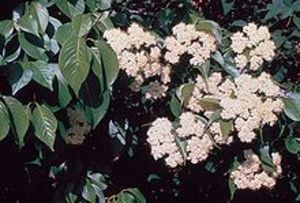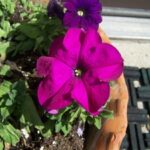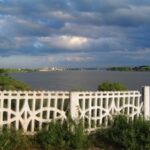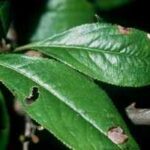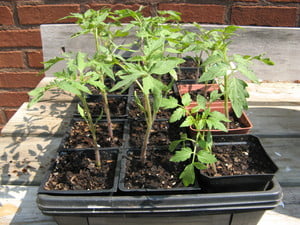Looking for a low maintenance shrub that’s showy? Try a viburnum shrub. Viburnum shrubs have a variety of leaf colors and shapes, they are not fussy plants to maintain, and most will flower and grow berries. Besides all that, many species of viburnum shrubs are native.
Viburnum shrubs also come in different sizes to fit many landscaping needs. There are the dwarfs which look great in a small or rock garden or to cover up an ugly area; there’s medium-sized shrubs which make a nice backdrop to a garden or look nice lined up against the house; and there’s the tall viburnum shrubs which can be used as an ornamental tree or a high hedge lining your property.
To give you an idea of what’s available among this plant species, I’ve put together a list of the more popular viburnum shrubs by size. It’s best to check with your local garden nursery to see which viburnum shrubs grow best in your area.
Dwarf Varieties of Viburnum Shrubs
The dwarf varieties include the very popular Viburnum opulus “Nanum” which is also known as the European Cranberrybush. This variety grows about 2 ft. tall by 2 ft. wide. Its compact mound is very dense and that makes it a great dwarf shrub in a rock garden. Very nice maple-leaf shaped foliage graces this plant and it doesn’t usually flower or berry, however, its appearance is very attractive. It has great fall color and is drought tolerant. This viburnum shrub grows best in Zones 3-7.
Viburnum obovatum”Reifler’s Dwarf” is considered to be a dwarf plant, however, it can grow 4-5 ft. tall and 5-6 ft. wide. It’s a very compact mounded shrub with white flowers in the spring and reddish-black berries in the fall. Its fall foliage color is a deep burgundy and it’s an evergreen viburnum shrub. This is a native shrub and is best grown in Zones 6-9.
Medium Varieties of Viburnum Shrubs
The most popular in this category is the native Nannyberry (Viburnum lentago). A very showy native shrub, of which I have two. They are very easy to grow and take well to pruning. Nannyberries can be 8-12 ft. high and 6-8 ft. wide. Very dense with long woody stems, they have snowball clusters of creamy white flowers in the spring and deep purple berries in the fall. Their glossy green leaves change to a yellow-orange during the fall. The Nannyberry is good in Zones 4-8.
Another popular variety is the native Mapleleaf viburnum (V. acerfolium) and it’s obviously named for the shape of its leaf. It has bigger medium green leaves than most viburnum shrubs and grows to be 4-6 ft. tall and 3-6 ft. wide. Very dense with snowball clusters of deep cream colored flowers in the spring and deep purple berries in the fall. Its fall color can be a golden yellow to almost deep purple. The Mapleleaf is a native shrub and is good in Zones 3-8.
Tall Varieties Of Viburnum Shrubs
There are several tall viburnum shrubs available and they’re great as a specimen plant or as an ornamental tree. The Seibold viburnum (V. seiboldii), can grow to 20 feet tall and 10-15 ft wide. The berries are red and the flowers are creamy white. It has green leaves and is good in Zones 5-7.
The Sweet Viburnum (V. odoratissimun), is a large evergreen that is very dense and can be used as a hedge. Its height can be 15-10 ft. tall and if used as an ornamental tree, its rounded canopy can be the same. As a hedge, they can be planted about 3 ft. apart. They have an abundance of creamy white flowers in the spring and showy red berries in the fall. Wouldn’t this make a very pretty hedge? Sweet Viburnum is good in Zones 8-10.
I’ve named just a few viburnum shrubs, however, there are many more varieties available. Viburnums are popular plants and just about every garden nursery will have several species. These plants are well worth looking into and I would suggest that you talk to your local nursery to find out which ones do best in your area. Many are native, they’re low maintenance, and they give an attractive display throughout the year.
Sources: University of Connecticutt
Offshoots
Kemper Center for Home Gardening
University of Illinois Extension
Ask The Plant Lady
High Country Gardens
Personal Experience
